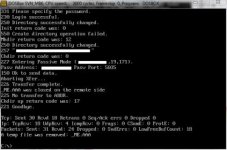This is not perfectly polished code, but it illustrates how to use _dos_findfirst and _dos_findnext (equivalent to DOS int 21/4E and 4F) to do a directory walk without using recursion.
It takes one command line argument - the starting directory. It should end with a / or you will get bad results. This code works in DOSBox and under DOS 6, and probably any version of DOS that has the 4E and 4F interrupts.
I would use something like this as the outer loop of a program that does puts against each file it comes up with. The error conditions you are looking for are a bad return code from the server when you do a put or a broken socket.
I suspect this works because DOS is using part of the file_ structure as a "cursor" so that it remembers where to start the search the next time that _dos_findnext is used. But I did not dig far enough into the reserved parts of the data structure to prove that.
-Mike
It takes one command line argument - the starting directory. It should end with a / or you will get bad results. This code works in DOSBox and under DOS 6, and probably any version of DOS that has the 4E and 4F interrupts.
I would use something like this as the outer loop of a program that does puts against each file it comes up with. The error conditions you are looking for are a bad return code from the server when you do a put or a broken socket.
I suspect this works because DOS is using part of the file_ structure as a "cursor" so that it remembers where to start the search the next time that _dos_findnext is used. But I did not dig far enough into the reserved parts of the data structure to prove that.
-Mike
Code:
#include <dos.h>
#include <malloc.h>
#include <stdio.h>
#include <string.h>
// These two arrays will serve as our stack of fileinfo structures and paths.
// You can save some space by just maintaining one path string and growing it
// and shrinking it as you add or remove directories instead of what we do here,
// which is lazy.
//
struct find_t fileInfos[32];
char *paths[32];
// This is just a temporary variable.
//
char filespec[128];
int main( int argc, char *argv[] ) {
int filesFound = 0;
int dirsFound = 0;
int stackPos = 0;
// Prime the pump - do the first findfirst on the root directory.
paths[stackPos] = strdup( argv[1] );
sprintf( filespec, "%s*.*", paths[stackPos] );
unsigned int rc = _dos_findfirst( filespec, (_A_NORMAL | _A_SUBDIR), &fileInfos[stackPos] );
while ( 1 ) {
if ( rc == 0 ) {
if ( fileInfos[stackPos].attrib & _A_SUBDIR ) {
dirsFound++;
// Exclude . and .. from the directory walk, or we will get nowhere fast.
if ( strcmp(fileInfos[stackPos].name, ".") != 0 && strcmp(fileInfos[stackPos].name, ".." ) != 0 ) {
int newPathLength = strlen( paths[stackPos] ) + strlen( fileInfos[stackPos].name ) + 2;
paths[stackPos+1] = (char *)malloc( newPathLength );
sprintf( paths[stackPos+1], "%s%s/", paths[stackPos], fileInfos[stackPos].name );
stackPos++;
// 32 might not be correct .. it might be closer to 40 based on the maximum allowable
// DOS path length. This is close enough for demo code.
if ( stackPos == 32 ) {
puts( "Too many levels of directories" );
break;
}
sprintf( filespec, "%s*.*", paths[stackPos] );
rc = _dos_findfirst( filespec, (_A_NORMAL | _A_SUBDIR), &fileInfos[stackPos] );
continue;
}
}
else if ( ((fileInfos[stackPos].attrib & _A_NORMAL) == _A_NORMAL) || ((fileInfos[stackPos].attrib & _A_RDONLY) == _A_RDONLY) ) {
filesFound++;
printf( "%s%s\n", paths[stackPos], fileInfos[stackPos].name );
}
rc = _dos_findnext( &fileInfos[stackPos] );
}
else {
free( paths[stackPos] );
if ( stackPos == 0 ) {
break;
}
--stackPos;
rc = _dos_findnext( &fileInfos[stackPos] );
}
}
printf( "Total subdirectories: %u, Total files: %u\n", dirsFound, filesFound );
return 0;
}

